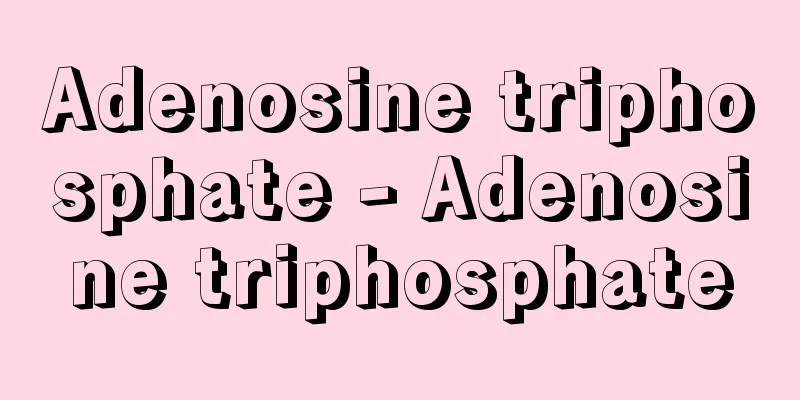Adenosine triphosphate - Adenosine triphosphate

|
A chemical compound found in all living organisms, composed of adenine, ribose, and three molecules of phosphate. It is abbreviated as ATP (adenosine triphosphate). In 1929, K. Lohmann in Germany, and Cyrus H. Fiske (1890-1978) and Yellapragda Subbarow (1895-1948) in the United States each independently succeeded in isolating it from muscle. It is particularly abundant in muscle, but it is present almost everywhere in the body and plays an important role. One of its roles is to provide phosphate groups to various compounds, but more importantly, it stores energy that organisms have acquired through various means and releases it when necessary. Of the three phosphate groups in an ATP molecule, the two at the ends have high-energy phosphate bonds, where energy is stored in the form of chemical energy. When ATP is hydrolyzed to ADP (adenosine diphosphate) and one molecule of phosphate, or AMP (adenylic acid) and two molecules of phosphate, the stored energy is released and becomes the driving force behind the countless tasks performed by organisms. This energy is rarely dissipated as heat, and in most cases is used with high efficiency in two ways: [Kenichi Kasai] When used as chemical energyEnergy is needed to synthesize substances necessary for life, such as proteins, nucleic acids, polysaccharides, coenzymes, and hormones, from simpler substances. In such cases, organisms often first use ATP to convert the raw materials into high-energy compounds so that subsequent reactions can be carried out without energy. In this case, the energy stored in ATP is transferred to the newly synthesized compound. For example, glucose is a very important substance as a raw material for many biological substances and as an energy source for organisms, but in order to actually be used, it needs to be converted into glucose-6-phosphate (phosphate ester with a hydroxyl group at the 6th position), which has a higher energy content. This is synthesized by the action of enzymes through the following reaction: Glucose + ATP In addition, ATP and three types of nucleoside triphosphates are required as materials for the synthesis of RNA (ribonucleic acid), and ATP is also used to create these high-energy phosphate compounds. In the case of protein synthesis, the process is quite complicated, but ATP is also required to convert amino acids into a high-energy state. [Kenichi Kasai] When converted into other forms of energyATP energy is used to perform countless tasks, such as muscle contraction, cilia movement, the uptake of various substances into cells (mechanical energy), the glow of fireflies (light energy), and the generation of electricity by electric eels (electrical energy). In this way, the chemical energy of ATP is freely converted into other forms of energy. As described above, ATP plays a key role in the energy metabolism of living organisms, storing, transporting, and releasing it in various forms as needed so that energy can be used effectively. It is constantly consumed for this purpose, but at the same time it is actively replenished. The main routes of replenishment are ATP production accompanying glycolysis, oxidative phosphorylation accompanying respiration, and photophosphorylation accompanying photosynthesis, in which ATP is produced by the phosphorylation of ADP. Oxidative phosphorylation is the most important for humans. ATP is produced during the transfer of electrons from NADH (reduced nicotinamide adenine dinucleotide) and FADH 2 (reduced flavin adenine dinucleotide) produced in the TCA cycle and other processes to oxygen via the respiratory chain, and this process takes place in the mitochondria within cells. [Kenichi Kasai] [References] | | | | | |©Shogakukan "> The chemical formula of adenosine triphosphate Source: Shogakukan Encyclopedia Nipponica About Encyclopedia Nipponica Information | Legend |
|
すべての生物に存在する化学物質でアデニン、リボース、3分子のリン酸により構成される。ATP(adenosine triphosphate)と略記する。 1929年にドイツのK・ローマンが、またアメリカでフィスケCyrus H. Fiske(1890―1978)とサバローYellapragda Subbarow(1895―1948)がそれぞれ独自に筋肉から単離することに成功した。とくに筋肉に多く存在するが、生物体内のほとんどあらゆる場所に存在して重要な働きをしている。リン酸基をいろいろな化合物に与えるのが一つの役割であるが、それよりも重要なのは、生物がいろいろな手段で獲得したエネルギーを蓄えておき、必要な場合には放出することにある。ATP分子の3個のリン酸基のうち、端の2個は高エネルギーリン酸結合をしており、ここに化学エネルギーの形でエネルギーが蓄えられている。そのATPが加水分解されてADP(アデノシン二リン酸)と1分子のリン酸へ、あるいはAMP(アデニル酸)と2分子のリン酸へ変化すると、蓄えられていたエネルギーが放出され、生物の行っている無数の仕事の原動力となる。このエネルギーは熱として発散することは少なく、多くの場合、次のような2通りの道筋によって高い効率で利用されている。 [笠井献一] 化学的エネルギーとして利用する場合タンパク質、核酸、多糖類、補酵素、ホルモンなど、生きるために必要な物質を、簡単な物質から生合成するためには、エネルギーが必要である。生物はこのような場合、まず最初にATPを使って、材料になる物質をエネルギーの高い化合物にし、それ以後の反応がエネルギーなしですむようにすることが多い。この場合、ATPに蓄えられていたエネルギーは新しくつくられた化合物に移されたことになる。たとえばグルコースは、多くの生体物質の原料として、また生物のエネルギー源として非常に重要な物質であるが、これが実際に利用されるためにはエネルギーのより高いグルコース-6-リン酸(6位ヒドロキシ基のリン酸エステル)に変えられる必要がある。これは酵素の働きによって次のような反応で合成される。 グルコース+ATP また、RNA(リボ核酸)の合成には材料としてATPおよび3種のヌクレオシド三リン酸が必要であるが、それらの高エネルギーリン酸化合物をつくるときにもATPが用いられる。タンパク質合成の場合も、道筋はかなり複雑であるが、アミノ酸をエネルギーの高い状態にするためにATPが必要である。 [笠井献一] 他の形のエネルギーに変換される場合筋肉の収縮、繊毛の運動、細胞内へのいろいろな物質の取り込み(力学的エネルギー)、ホタルの発光(光エネルギー)、デンキウナギの発電(電気エネルギー)など、無数の仕事がATPのエネルギーを利用して行われる。このように、ATPの化学的エネルギーは他の形のエネルギーに自在に変換されている。 以上のように、ATPは、エネルギーが有効に利用されるように、蓄え、運搬し、必要に応じてさまざまな形で放出するという、生物のエネルギー代謝の主役となっている。そのために絶えず消費されていくが、それと同時に活発に補給されている。その補給経路のうちで主要なものは、解糖に伴うATP生産、呼吸に伴う酸化的リン酸化、光合成に伴う光リン酸化などであり、ADPのリン酸化によってATPがつくられる。人間にとってもっとも重要なのは酸化的リン酸化である。これは、TCA回路などで生産されたNADH(還元型ニコチンアミドアデニンジヌクレオチド)やFADH2(還元型フラビンアデニンジヌクレオチド)の電子が、呼吸鎖(さ)を伝って酸素に渡される間にATPがつくられるものであり、細胞内のミトコンドリアで行われている。 [笠井献一] [参照項目] | | | | | |©Shogakukan"> アデノシン三リン酸の化学式 出典 小学館 日本大百科全書(ニッポニカ)日本大百科全書(ニッポニカ)について 情報 | 凡例 |
>>: Adenovirus infection - Adenovirus infection
Recommend
Aula Regia (English spelling) Aula Regia
…Only the hot baths remain in their original form...
Lake Suwa
A lake in the Suwa Basin in central Nagano Prefec...
Oropendola
...The beak is somewhat elongated and conical, st...
Corruption
...On the other hand, the political system itself...
Odoriko
…In a newborn baby's head, the edges of the f...
Hosta - Giboshi
A cold-tolerant perennial plant of the lily famil...
Calimala (English spelling) Arte di Calimala
One of the guilds in medieval Florence. Its actual...
Jingnan (English spelling)
One of the ten states of the Five Dynasties in Chi...
Cake - ke-ki (English spelling) cake
It refers to Western-style fresh confections, fru...
Pherōs (English spelling)
… However, the idea that urine is useful not only...
Yodo Domain
The Fudai Domain ruled the area around Yodo in Ya...
Princess Aurora
...The good spirit Lilac prophesies that the prin...
The Land of Izumo
A woman who is said to have laid the foundations o...
Appen, K.von (English spelling) AppenKvon
…His work with the Berliner Ensemble won worldwid...
Chicken manure
It is a fertilizer made from dried chicken droppi...









